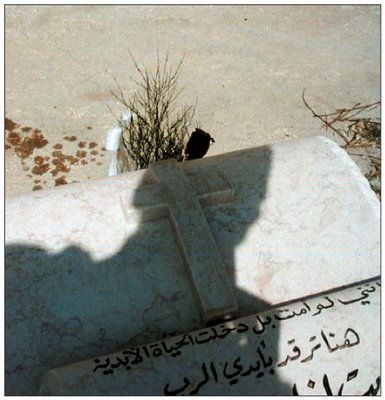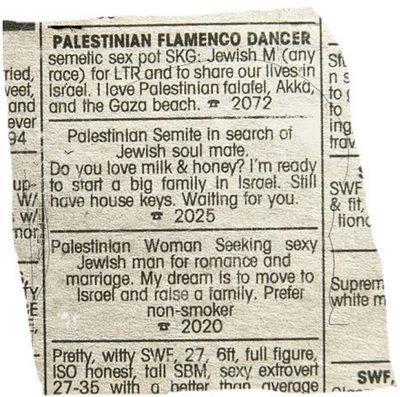 Every morning I walk my dog around Powderhorn Park in Minneapolis. Nothing special, just the comfortable familiarity that comes with wandering beloved terrain day in and day out. But sometimes I wonder: what if this was all gone, if I was banned from ever coming here again? How, then, would I cherish this mundane ritual? Artist Emily Jacir addresses these issues head-on, telling the stories of people who don’t have the luxury of pondering such what-ifs--Palestinians in exile, both within Israel and abroad.
Every morning I walk my dog around Powderhorn Park in Minneapolis. Nothing special, just the comfortable familiarity that comes with wandering beloved terrain day in and day out. But sometimes I wonder: what if this was all gone, if I was banned from ever coming here again? How, then, would I cherish this mundane ritual? Artist Emily Jacir addresses these issues head-on, telling the stories of people who don’t have the luxury of pondering such what-ifs--Palestinians in exile, both within Israel and abroad.The reality of not being able to return home, or to move freely, is at the heart of Jacir’s recent project Where We Come From (2001–2003). A Palestinian artist with an American passport, Jacir can travel where other Palestinians can’t--into and out of the Occupied Territories, to her parents’ home in Ramallah and to her studio in New York. For the project she asked exiled Palestinians: "If I could do anything for you, anywhere in Palestine, what would it be?" She then took their answers--"Go to my mother’s grave in Jerusalem on her birthday and put flowers and pray." "Drink the water in my parents’ village." "Go to Gaza and eat Sayadiyeh."--and set out to fulfill them.
She paid the phone bill of a man who is forbidden from going to the Jerusalem post office himself. She delivered hugs and kisses to missed family members, took a snapshot of an ancestral home, played soccer with a random boy in Haifa, lit a candle on the beach. She documented her encounters with a photo or video, each shot from her vantage point, a perspective that allowed the person to project themselves into forbidden spaces, if only virtually. The work’s presentation is serene: requests, printed in English and Arabic, are mounted beside the documentation. In this stillness, the border between worlds seems both photograph-thin and unmercifully impassable.
These themes--exile and memory--permeate much of Jacir’s work. In From Texas With Love (2002), she uses an American icon of freedom--a wide-open highway--to evoke the smothered dreams of Palestinians. Again, she began with a question: “If you had the freedom to get in a car and drive for one hour without being stopped (imagine that there is no Israeli military occupation, no Israeli soldiers, no Israeli checkpoints and roadblocks, no 'bypass' road) what song would you listen to?” She set their selections--51 songs ranging from Madonna’s "Material Girl" to traditional Arabic music--to an expansive hourlong video, a continuous shot down a seemingly unending roadway. Created during an artist residency in Texas, the piece was about "being in a place so incredible and beautiful and being able to drive freely and to listen to music, and at the same time wanting to cry because this cannot happen back home."
 But while Jacir’s work is tinged with sadness, it’s also spiked with humor. In her subversive Sexy Semite (2000–2002), she peppered the Village Voice with personal ads for Palestinians looking to settle down in Israel. One asks "Do you love milk & honey? I’m ready to start a big family in Israel. Still have house keys." Another, more pointed, reads: "You stole the land. May as well take the women! Redhead Palestinian ready to be colonized by your army." The ads slyly suggest a way around an irreconcilable issue in the Middle East peace process: by marrying Israelis, Palestinians can gain citizenship and thus sidestep calls for the "right of return" (an unfulfilled provision of UN Resolution 194 that promises Palestinian refugees the chance to return home). But, given their placement in the love-wanted section instead of world news, the ads seem less about policy than the personal. Individual lives--people seeking love, a sense of home, the kind of daily routine you and I enjoy--are profoundly impacted by the occupation. And perhaps it’s through individual relationships that the conflict can ease. As one ad punned: "Palestinian Male working in a difficult occupation. I’m looking for a Jewish Beauty... Only you can help me find my way Home."
But while Jacir’s work is tinged with sadness, it’s also spiked with humor. In her subversive Sexy Semite (2000–2002), she peppered the Village Voice with personal ads for Palestinians looking to settle down in Israel. One asks "Do you love milk & honey? I’m ready to start a big family in Israel. Still have house keys." Another, more pointed, reads: "You stole the land. May as well take the women! Redhead Palestinian ready to be colonized by your army." The ads slyly suggest a way around an irreconcilable issue in the Middle East peace process: by marrying Israelis, Palestinians can gain citizenship and thus sidestep calls for the "right of return" (an unfulfilled provision of UN Resolution 194 that promises Palestinian refugees the chance to return home). But, given their placement in the love-wanted section instead of world news, the ads seem less about policy than the personal. Individual lives--people seeking love, a sense of home, the kind of daily routine you and I enjoy--are profoundly impacted by the occupation. And perhaps it’s through individual relationships that the conflict can ease. As one ad punned: "Palestinian Male working in a difficult occupation. I’m looking for a Jewish Beauty... Only you can help me find my way Home."
No comments:
Post a Comment